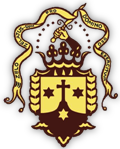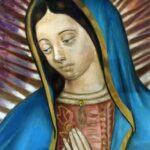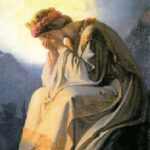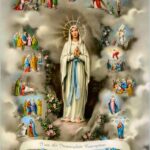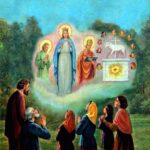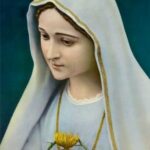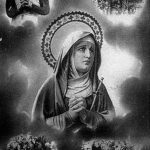The Apparitions of Lourdes
Lourdes. Between the 11th of February and the 16th of July 1858, the Most Holy Virgin Mary appeared eighteen times to Saint Bernadette Soubirous (1844-1879), a poor illiterate fourteen-year-old girl, in the grotto of the Massabielle, locality on the outskirts of the town of Lourdes, France, in the Pyrenean foothills.
Already in Saint Bernadette’s life, multitudes of Catholics believed in the Apparitions of the Virgin Mary as a channel of God’s graces, and Pope Saint Pius IX authorized the veneration of the Virgin Mary in Lourdes in 1862, some seventeen years before Bernadette’s death. From then on, the Virgin Mary’s title of Our Lady of Lourdes has been motive for great veneration, and Her Sanctuary has been one of the most visited in the world, with millions of pilgrims each year.
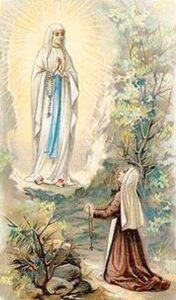
In the third Apparition, the girl spoke to the Lady, who asked her: “Will you do Me the favour of coming here for fifteen days?” Bernadette assented from the heart, without pausing to think of the consequences. To her promise She responded with another promise: “I do not promise to make you happy in this life, but in the other.” These few words seemed sweet under the gaze of Her Who pronounced them.
In successive Apparitions, Mary Most Holy asked for penance and prayer for sinners: “Penance!… Pray to God for the conversion of sinners!” Then She asked her to kneel and told her: “Kiss the ground as penance for sinners… for the conversion of sinners.” Her face was sad. Bernadette, likewise sad, replied that she would. The Virgin, always respectful, had asked her “if that bothered her” “Oh, no” the girl had replied from the heart. She felt ready for anything to please that Heavenly Friend who seemed so sad when speaking of sinners, though the people thought her mad when she did such things. From the depths of her heart, with just a glance, she had understood that in the world there was only one thing really sad: sin.
On the 25th of February, the Virgin told her to eat from the plants growing wild there, and that she should take water from the spring, to do which She taught her to hollow out the soil with a finger. On making a hollow in the mud and attempting to drink, Bernadette muddied her face, and her gestures and appearance were cause for scepticism among many of the 350 there present. To console the Lady she felt ready for anything. When she did these things, like kissing the ground, hollowing out the muddy soil and eating grass, enthusiasm flagged; the people understood nothing. To these strange exercises, Bernadette gave a simple and satisfactory explanation: “The vision told me to do them as a penance, for me first and then for the rest.”
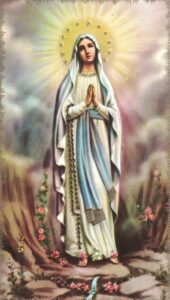 Saint Bernadette’s action in kissing the damp ground and making a hollow, not without repugnance, was an austere penance. In the course of her life, she was called to a more interior penance: the acceptance of the crosses chosen for her by the Lord, crosses which turned out to be heavier in the measure of her mission, associated to the work of Redemption. Thus, counted among them are the moral trials, more than can be noted; also the trials of sicknesses which medical reports show were atrocious and unremitting. Bernadette suffered it all with abandonment for love of God and His Most Holy Mother.
Saint Bernadette’s action in kissing the damp ground and making a hollow, not without repugnance, was an austere penance. In the course of her life, she was called to a more interior penance: the acceptance of the crosses chosen for her by the Lord, crosses which turned out to be heavier in the measure of her mission, associated to the work of Redemption. Thus, counted among them are the moral trials, more than can be noted; also the trials of sicknesses which medical reports show were atrocious and unremitting. Bernadette suffered it all with abandonment for love of God and His Most Holy Mother.
The spring did not appear at once; yet shortly afterwards the water rose up, later witness to numerous miracles. The spring which appeared on that 25th of February 1858 was to produce a hundred thousand litres a day, continuously, from that date up till today.
At Saint Bernadette’s repeated petition to reveal Her name, on the 25th of March 1858 (in Her sixteenth Apparition), the Lady changed the rosary around, wearing it on the right arm. She separated Her hands, and stretched them out with the palms towards the ground. Majesty sprang from that simple gesture; Her maidenly silhouette gave off grandeur; Her youth, a weight of eternity. With a harmonious movement She then joined Her hands at breast height, raised Her eyes to Heaven and told Bernadette: “I am the Immaculate Conception.” After the Apparition, Bernadette understood of a sudden that those words, which she had never heard before, were in reality difficult, complicated; and to tell the truth she did not even understand them. She felt that she would forget her ‘commission’. Quickly, she had to go to the parish rectory. Bernadette grasped the syllables of the second word, which she was already forgetting, and started out to run, repeating the strange words ‘Immaculate Conception’ in a low voice.
Confident, because she had succeeded in holding on to the two words she was at the point of forgetting, Bernadette nevertheless felt ever more intrigued and even somewhat disappointed. The same as all the rest, she would have liked to believe that the marvellous Apparition was the Most Holy Virgin; who, then, was this ‘Conception’?
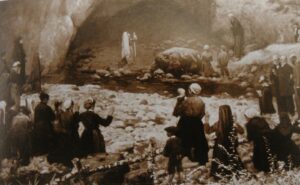
She pushed at the door and launched her message into the Parish Priest’s face, almost point-blank: “I am the Immaculate Conception.” Bernadette, realizing how brusque the phrase was, repeated confidently: “She said ‘I am the Immaculate Conception’.” “A lady cannot have that name… You are deceiving me! Do you know what that means?” Bernadette sadly shook her head. “Then how can you say it, if you have not understood it?” “I repeated it the whole way.” The Parish Priest felt moved at the evidence of the supernatural, and could only say: “Go back home. I will see you another day.” Bernadette left completely bewildered. If the Priest didn’t know, who would?
The expression was quite foreign to Bernadette’s vocabulary and at first was in fact a motive of disconcertion for the Lourdes Parish Priest as well as for other Church and civil authorities. The Dogma of the Virgin Mary’s Immaculate Conception had been solemnly proclaimed on the 8th of December 1854, three years previously. The Immaculate Conception is She who, free from all personal sin, took up the cross of our penance, from the Bethlehem crib to the poor Nazareth home, and above all on Golgotha, where She experienced the worst dolour a mother’s heart can possibly have, the dolour of the Reparation and Redemption.
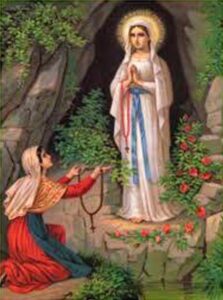 Saint Bernadette Soubirous kept up a consistent attitude of calm during all the captious interrogations to which she was subjected, without changing her account or her attitude, not trying to show a knowledge beyond that expressed in describing the visions. The last interrogation before the Church Commission, presided over by the Bishop of Tarbes, was on the 1st of December 1860. The agèd Bishop ended up moved when Bernadette repeated the gesture and words of the Virgin on the 25th of March 1858: “I am the Immaculate Conception.” In 1862, the Bishop published a pastoral letter in which he declared that “the Immaculate Mother of God had truly appeared to Bernadette.” That same year, Pope Saint Pius IX authorized the local Bishop to allow veneration, in various manners, of the Virgin Mary in Lourdes. From then on the different Pontiffs have supported the devotion and pilgrimage to the Sanctuary. Pope Saint Pius X extended the celebration of the Commemoration to the whole Church. Pope Saint Pius XI canonized Saint Bernadette Soubirous on the Feast of the Immaculate Conception in 1933. In 1937, the same Saint Pius XI appointed Cardinal Eugenio Pacelli (Saint Pius XII) as Papal Delegate personally to visit and venerate the Virgin in Lourdes. In commemoration of the Centenary of the Dogma of the Immaculate Conception, Pope Saint Pius XII decreed the celebration of the first Marian Year in the history of the Church, while describing the events of Lourdes in the following words: “And it seems as if the Most Holy Virgin had wished to confirm in a prodigious way the declaration pronounced by the Vicar of Her Divine Son on earth, to the applause of the whole Church. Since four years had not yet passed from the Dogma when, close by a town in France in the Pyrenean foothills, the Most Holy Virgin, dressed in white, with a snow-white mantle and girded with a blue sash, appeared with youthful and genial aspect in the cave of Massabielle to an innocent and simple girl, to whom, as she insisted in knowing the name of the one who had deigned to appear, She, with a gentle smile and raising Her eyes to Heaven, replied: ‘I am the Immaculate Conception.’ The faithful understood this quite well, as was natural, and they flocked to the Lourdes Grotto from all parts in pious pilgrimages, in almost incalculable crowds, revived their faith, stimulated their piety and strove to adjust their lives to Christ’s precepts.”
Saint Bernadette Soubirous kept up a consistent attitude of calm during all the captious interrogations to which she was subjected, without changing her account or her attitude, not trying to show a knowledge beyond that expressed in describing the visions. The last interrogation before the Church Commission, presided over by the Bishop of Tarbes, was on the 1st of December 1860. The agèd Bishop ended up moved when Bernadette repeated the gesture and words of the Virgin on the 25th of March 1858: “I am the Immaculate Conception.” In 1862, the Bishop published a pastoral letter in which he declared that “the Immaculate Mother of God had truly appeared to Bernadette.” That same year, Pope Saint Pius IX authorized the local Bishop to allow veneration, in various manners, of the Virgin Mary in Lourdes. From then on the different Pontiffs have supported the devotion and pilgrimage to the Sanctuary. Pope Saint Pius X extended the celebration of the Commemoration to the whole Church. Pope Saint Pius XI canonized Saint Bernadette Soubirous on the Feast of the Immaculate Conception in 1933. In 1937, the same Saint Pius XI appointed Cardinal Eugenio Pacelli (Saint Pius XII) as Papal Delegate personally to visit and venerate the Virgin in Lourdes. In commemoration of the Centenary of the Dogma of the Immaculate Conception, Pope Saint Pius XII decreed the celebration of the first Marian Year in the history of the Church, while describing the events of Lourdes in the following words: “And it seems as if the Most Holy Virgin had wished to confirm in a prodigious way the declaration pronounced by the Vicar of Her Divine Son on earth, to the applause of the whole Church. Since four years had not yet passed from the Dogma when, close by a town in France in the Pyrenean foothills, the Most Holy Virgin, dressed in white, with a snow-white mantle and girded with a blue sash, appeared with youthful and genial aspect in the cave of Massabielle to an innocent and simple girl, to whom, as she insisted in knowing the name of the one who had deigned to appear, She, with a gentle smile and raising Her eyes to Heaven, replied: ‘I am the Immaculate Conception.’ The faithful understood this quite well, as was natural, and they flocked to the Lourdes Grotto from all parts in pious pilgrimages, in almost incalculable crowds, revived their faith, stimulated their piety and strove to adjust their lives to Christ’s precepts.”
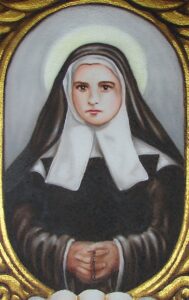
In colloquial language “Lourdes” has become synonymous with “miracles”. For Christ, miracles are not the most important thing: “Blessed be those who have not seen and have not touched and who have believed.” The Message of Lourdes is very brief: “Prayer and penance… I am the Immaculate Conception.” Mary Most Holy does not base Her message on arguments, but on God’s omnipotent works. Miracles are the sign that give divine authority to the Message, as when Christ cured the paralytic saying: “Well, so that you may know that the Son of Man has power on earth to forgive sins… I say to you, rise up, take your bed and go to your home.” This divine authority, manifested in miracles, obliges man to obey, just as when the Prophet Jonas, miraculously saved from the whale, told the king: “If you and your subjects are not converted to the Lord God of Israel, and do not do penance, Nineveh will be destroyed”; and the king of Nineveh, moved to conversion, having cast aside his regal attire, dressed in sackcloth, covered his head with ashes and published an order saying: “All the subjects of my empire shall dress in sackcloth, fast, cover their heads with ashes, and cry out with all their soul to the Lord God of Israel, everyone converting from his evil life. Who knows whether the Lord will thereby change His mind and forgive us! And the fury of His Wrath be appeased, so that we may not perish!”
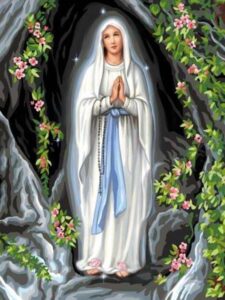
This message of “prayer and penance” brings us back to the start of the Gospel, to the preaching of John the Baptist, who prepared the way for Christ’s First Coming. This invitation reached the middle of the nineteenth century, when the dawn of technical progress began to transform life. The era of material development began, but spiritual values were eclipsed. This was the moment chosen by Our Lady to remind us of the value and need for prayer and penance, in preparation for the Apocalyptic Era and for Christ’s Glorious Second Coming.
Mary Bernadette Soubirous was proclaimed Saint by Saint Pius XI on the 8th of December 1933. For more details on the Apparitions of Lourdes, read the life of this Saint, whose feast is on the 16th of April, in the Palmarian Lives of the Saints.
Lourdes. Between the 11th of February and the 16th of July 1858, the Most Holy Virgin Mary appeared eighteen times to Saint Bernadette Soubirous (1844-1879), a poor illiterate fourteen-year-old girl, in the grotto of the Massabielle, locality on the outskirts of the town of Lourdes, France, in the Pyrenean foothills.
Already in Saint Bernadette’s life, multitudes of Catholics believed in the Apparitions of the Virgin Mary as a channel of God’s graces, and Pope Saint Pius IX authorized the veneration of the Virgin Mary in Lourdes in 1862, some seventeen years before Bernadette’s death. From then on, the Virgin Mary’s title of Our Lady of Lourdes has been motive for great veneration, and Her Sanctuary has been one of the most visited in the world, with millions of pilgrims each year.

In the third Apparition, the girl spoke to the Lady, who asked her: “Will you do Me the favour of coming here for fifteen days?” Bernadette assented from the heart, without pausing to think of the consequences. To her promise She responded with another promise: “I do not promise to make you happy in this life, but in the other.” These few words seemed sweet under the gaze of Her Who pronounced them.
In successive Apparitions, Mary Most Holy asked for penance and prayer for sinners: “Penance!… Pray to God for the conversion of sinners!” Then She asked her to kneel and told her: “Kiss the ground as penance for sinners… for the conversion of sinners.” Her face was sad. Bernadette, likewise sad, replied that she would. The Virgin, always respectful, had asked her “if that bothered her” “Oh, no” the girl had replied from the heart. She felt ready for anything to please that Heavenly Friend who seemed so sad when speaking of sinners, though the people thought her mad when she did such things. From the depths of her heart, with just a glance, she had understood that in the world there was only one thing really sad: sin.
On the 25th of February, the Virgin told her to eat from the plants growing wild there, and that she should take water from the spring, to do which She taught her to hollow out the soil with a finger. On making a hollow in the mud and attempting to drink, Bernadette muddied her face, and her gestures and appearance were cause for scepticism among many of the 350 there present. To console the Lady she felt ready for anything. When she did these things, like kissing the ground, hollowing out the muddy soil and eating grass, enthusiasm flagged; the people understood nothing. To these strange exercises, Bernadette gave a simple and satisfactory explanation: “The vision told me to do them as a penance, for me first and then for the rest.”

Saint Bernadette’s action in kissing the damp ground and making a hollow, not without repugnance, was an austere penance. In the course of her life, she was called to a more interior penance: the acceptance of the crosses chosen for her by the Lord, crosses which turned out to be heavier in the measure of her mission, associated to the work of Redemption. Thus, counted among them are the moral trials, more than can be noted; also the trials of sicknesses which medical reports show were atrocious and unremitting. Bernadette suffered it all with abandonment for love of God and His Most Holy Mother.
The spring did not appear at once; yet shortly afterwards the water rose up, later witness to numerous miracles. The spring which appeared on that 25th of February 1858 was to produce a hundred thousand litres a day, continuously, from that date up till today.
At Saint Bernadette’s repeated petition to reveal Her name, on the 25th of March 1858 (in Her sixteenth Apparition), the Lady changed the rosary around, wearing it on the right arm. She separated Her hands, and stretched them out with the palms towards the ground. Majesty sprang from that simple gesture; Her maidenly silhouette gave off grandeur; Her youth, a weight of eternity. With a harmonious movement She then joined Her hands at breast height, raised Her eyes to Heaven and told Bernadette: “I am the Immaculate Conception.” After the Apparition, Bernadette understood of a sudden that those words, which she had never heard before, were in reality difficult, complicated; and to tell the truth she did not even understand them. She felt that she would forget her ‘commission’. Quickly, she had to go to the parish rectory. Bernadette grasped the syllables of the second word, which she was already forgetting, and started out to run, repeating the strange words ‘Immaculate Conception’ in a low voice.
Confident, because she had succeeded in holding on to the two words she was at the point of forgetting, Bernadette nevertheless felt ever more intrigued and even somewhat disappointed. The same as all the rest, she would have liked to believe that the marvellous Apparition was the Most Holy Virgin; who, then, was this ‘Conception’?

She pushed at the door and launched her message into the Parish Priest’s face, almost point-blank: “I am the Immaculate Conception.” Bernadette, realizing how brusque the phrase was, repeated confidently: “She said ‘I am the Immaculate Conception’.” “A lady cannot have that name… You are deceiving me! Do you know what that means?” Bernadette sadly shook her head. “Then how can you say it, if you have not understood it?” “I repeated it the whole way.” The Parish Priest felt moved at the evidence of the supernatural, and could only say: “Go back home. I will see you another day.” Bernadette left completely bewildered. If the Priest didn’t know, who would?
The expression was quite foreign to Bernadette’s vocabulary and at first was in fact a motive of disconcertion for the Lourdes Parish Priest as well as for other Church and civil authorities. The Dogma of the Virgin Mary’s Immaculate Conception had been solemnly proclaimed on the 8th of December 1854, three years previously. The Immaculate Conception is She who, free from all personal sin, took up the cross of our penance, from the Bethlehem crib to the poor Nazareth home, and above all on Golgotha, where She experienced the worst dolour a mother’s heart can possibly have, the dolour of the Reparation and Redemption.

Saint Bernadette Soubirous kept up a consistent attitude of calm during all the captious interrogations to which she was subjected, without changing her account or her attitude, not trying to show a knowledge beyond that expressed in describing the visions. The last interrogation before the Church Commission, presided over by the Bishop of Tarbes, was on the 1st of December 1860. The agèd Bishop ended up moved when Bernadette repeated the gesture and words of the Virgin on the 25th of March 1858: “I am the Immaculate Conception.” In 1862, the Bishop published a pastoral letter in which he declared that “the Immaculate Mother of God had truly appeared to Bernadette.” That same year, Pope Saint Pius IX authorized the local Bishop to allow veneration, in various manners, of the Virgin Mary in Lourdes. From then on the different Pontiffs have supported the devotion and pilgrimage to the Sanctuary. Pope Saint Pius X extended the celebration of the Commemoration to the whole Church. Pope Saint Pius XI canonized Saint Bernadette Soubirous on the Feast of the Immaculate Conception in 1933. In 1937, the same Saint Pius XI appointed Cardinal Eugenio Pacelli (Saint Pius XII) as Papal Delegate personally to visit and venerate the Virgin in Lourdes. In commemoration of the Centenary of the Dogma of the Immaculate Conception, Pope Saint Pius XII decreed the celebration of the first Marian Year in the history of the Church, while describing the events of Lourdes in the following words: “And it seems as if the Most Holy Virgin had wished to confirm in a prodigious way the declaration pronounced by the Vicar of Her Divine Son on earth, to the applause of the whole Church. Since four years had not yet passed from the Dogma when, close by a town in France in the Pyrenean foothills, the Most Holy Virgin, dressed in white, with a snow-white mantle and girded with a blue sash, appeared with youthful and genial aspect in the cave of Massabielle to an innocent and simple girl, to whom, as she insisted in knowing the name of the one who had deigned to appear, She, with a gentle smile and raising Her eyes to Heaven, replied: ‘I am the Immaculate Conception.’ The faithful understood this quite well, as was natural, and they flocked to the Lourdes Grotto from all parts in pious pilgrimages, in almost incalculable crowds, revived their faith, stimulated their piety and strove to adjust their lives to Christ’s precepts.”

In colloquial language “Lourdes” has become synonymous with “miracles”. For Christ, miracles are not the most important thing: “Blessed be those who have not seen and have not touched and who have believed.” The Message of Lourdes is very brief: “Prayer and penance… I am the Immaculate Conception.” Mary Most Holy does not base Her message on arguments, but on God’s omnipotent works. Miracles are the sign that give divine authority to the Message, as when Christ cured the paralytic saying: “Well, so that you may know that the Son of Man has power on earth to forgive sins… I say to you, rise up, take your bed and go to your home.” This divine authority, manifested in miracles, obliges man to obey, just as when the Prophet Jonas, miraculously saved from the whale, told the king: “If you and your subjects are not converted to the Lord God of Israel, and do not do penance, Nineveh will be destroyed”; and the king of Nineveh, moved to conversion, having cast aside his regal attire, dressed in sackcloth, covered his head with ashes and published an order saying: “All the subjects of my empire shall dress in sackcloth, fast, cover their heads with ashes, and cry out with all their soul to the Lord God of Israel, everyone converting from his evil life. Who knows whether the Lord will thereby change His mind and forgive us! And the fury of His Wrath be appeased, so that we may not perish!”

This message of “prayer and penance” brings us back to the start of the Gospel, to the preaching of John the Baptist, who prepared the way for Christ’s First Coming. This invitation reached the middle of the nineteenth century, when the dawn of technical progress began to transform life. The era of material development began, but spiritual values were eclipsed. This was the moment chosen by Our Lady to remind us of the value and need for prayer and penance, in preparation for the Apocalyptic Era and for Christ’s Glorious Second Coming.
Mary Bernadette Soubirous was proclaimed Saint by Saint Pius XI on the 8th of December 1933. For more details on the Apparitions of Lourdes, read the life of this Saint, whose feast is on the 16th of April, in the Palmarian Lives of the Saints.
